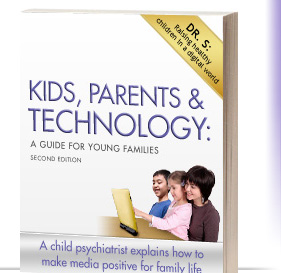So, you’re about to have a baby, and there are so many things to do. You decorate your nursery… start interviewing caregivers…and establish a college fund. And, you should start creating a digital media plan, determining how (and how often) your child will use computers, TV, video games, etc. in the years ahead. Parents may not realize it, but they’re hardwiring circuits into their kids’ brains every day. When you give your child unsupervised access to media, you’re basically turning that job over to strangers.
Used properly, electronic content is a good thing. But emerging research regarding “media-soaked kids” reveals that technology can short-circuit healthy development. Studies show that the more time kids spend watching TV, the less time they spend socializing and learning. And that adolescents who play solitary video games become isolated in other ways, too.
In addition:
- A baby’s brain is an amazing phenomenon: flexible, unspoiled, and programmed to build itself in response to its environment. It’s the parent’s responsibility to keep that precious brain “green” by managing what baby is exposed to from birth.
- Kids’ consumption of media is an epidemic, not unlike the obesity epidemic. Left to their own devices in the kitchen, most kids choose junk food. Same goes for technology. Many kids now spend more time with electronic media than they do in school or with their families…what, exactly, are they ingesting?
- Remember the junk food metaphor? A healthy media diet consists of five food groups, or “Growth Opportunities”: Family Relationships, Socialization, Values, Education, and Entertainment (which should be treated like dessert). If media doesn’t serve a clear, positive purpose, kids shouldn’t consume it.
- Parents need not fear technology. Home electronics are merely appliances that exist to serve your family. But just as you’d never give a young child free reign over the stove, don’t hand over the mouse or remote.
- Technology makes a poor babysitter. Parents should choose the media kids consume and be present and involved when kids do so. Move the PC away from the wall, out into the center of the room, and chaperoning kids on their adventures in cyberspace.
- Parents should create a media plan for each child that includes both limits and benefits. The plan should encourage better family relationships, socialization, values, and education enrichment. Make entertainment only a minor part of the plan.
Avoid any device that does not serve clear family and child-centered aims or provides only entertainment, especially if it will isolate the child. Schedule your time to be in the child’s direct presence and put limits of time and place for its use (or negotiate with older children) from the very beginning. Then, begin applying your new approach gradually to all other tech devices kids use (from TV through video games, iPods and iPads.)
Technology has expanded so rapidly, it’s like the Wild West for most of us—vast, exhilarating, unexplored. But the Wild West is not a place to turn kids loose. My goal is to give parents a roadmap for leading their kids through this new frontier, safe and sound.
Article by Eitan ‘Dr. S®’ Schwarz, MD
©All rights reserved



A Child Psychiatrist Takes a Stand on the Dangers & Delights of Digital Media A Plan for Raising Healthy Kids in a High-tech World
So, you’re about to have a baby, and there are so many things to do. You decorate your nursery… start interviewing caregivers…and establish a college fund. And, you should start creating a digital media plan, determining how (and how often) your child will use computers, TV, video games, etc. in the years ahead. Parents may not realize it, but they’re hardwiring circuits into their kids’ brains every day. When you give your child unsupervised access to media, you’re basically turning that job over to strangers.
Used properly, electronic content is a good thing. But emerging research regarding “media-soaked kids” reveals that technology can short-circuit healthy development. Studies show that the more time kids spend watching TV, the less time they spend socializing and learning. And that adolescents who play solitary video games become isolated in other ways, too.
In addition:
Avoid any device that does not serve clear family and child-centered aims or provides only entertainment, especially if it will isolate the child. Schedule your time to be in the child’s direct presence and put limits of time and place for its use (or negotiate with older children) from the very beginning. Then, begin applying your new approach gradually to all other tech devices kids use (from TV through video games, iPods and iPads.)
Technology has expanded so rapidly, it’s like the Wild West for most of us—vast, exhilarating, unexplored. But the Wild West is not a place to turn kids loose. My goal is to give parents a roadmap for leading their kids through this new frontier, safe and sound.
Article by Eitan ‘Dr. S®’ Schwarz, MD
©All rights reserved